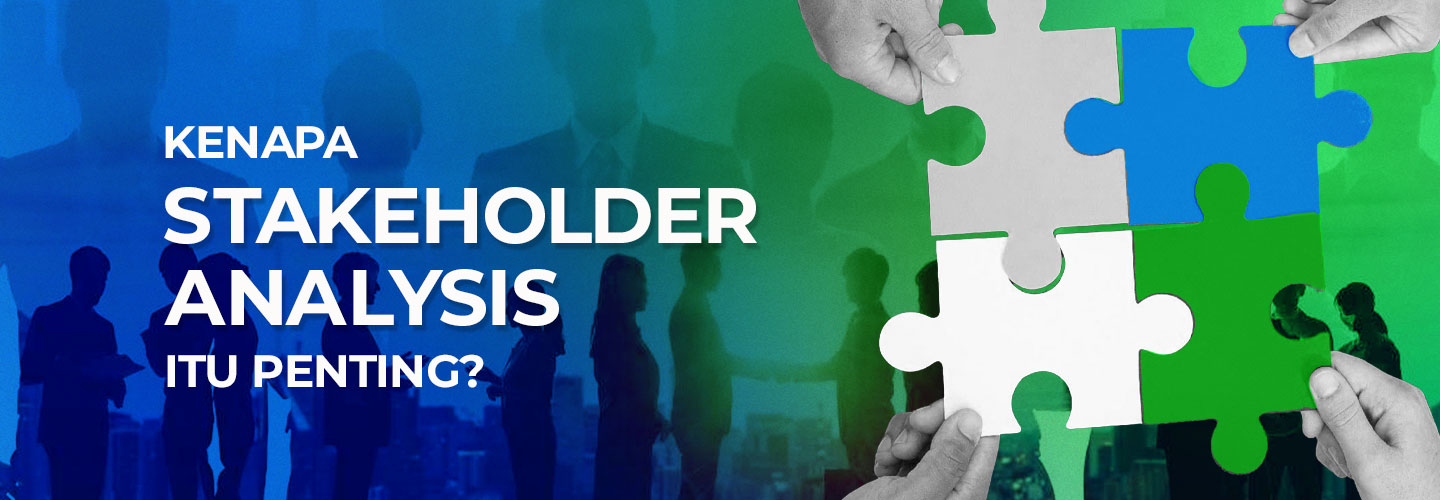Peran Penting Stakeholder Analysis dalam Sebuah Organisasi

Melakukan identifikasi atau pengelompokkan para stakeholder merupakan sesuatu yang krusial. Keterlibatannya berkaitan dengan pencapaian serangkaian tujuan dalam sebuah organisasi maupun perusahaan.
Stakeholder analysis merupakan pemahaman lebih dalam terkait kebutuhan dari para stakeholder yang terlibat. Untuk memahami secara menyeluruh apa arti analisis pemangku kepentingan, pertama-tama, kita perlu mengetahui apa itu proyek dan apa itu pemangku kepentingan.
Apa Itu Stakeholder?
Sebutan stakeholder mengacu pada satu atau sekelompok orang yang merupakan bagian dari organisasi yang akan terpengaruh oleh suatu proyek yang dilakukan oleh tim. Mereka akan terpengaruh karena menjadi bagian dari tim yang terlibat dalam proyek tersebut.
Stakeholder biasanya diklasifikasikan menjadi dua kategori yaitu stakeholder internal dan eksternal. Stakeholder internal adalah orang-orang yang bekerja di organisasi dan akan berkontribusi langsung dalam sebuah proyek baik menjadi anggota maupun pemimpin.
Sementara itu, stakeholder eksternal adalah entitas yang berada di luar organisasi. Contoh stakeholder eksternal adalah pemerintah, pelanggan, atau investor. Stakeholder juga dibagi menjadi tiga tingkatan utama atas prioritasnya. Namun, stakeholder terpenting adalah karyawan, pelanggan, dan investor terkait peranannya agar bisnis bisa tetap beroperasi.
Apa Itu Stakeholder Analysis?
Sekarang mengetahui pengertian stakeholder, apa itu stakeholder analysis dalam project management? Secara sederhana, stakeholder analysis adalah proses mengidentifikasi para stakeholder potensial dan memisahkannya ke dalam kategori dan kelompok yang berbeda sesuai tingkat minat, partisipasi, dan pengaruhnya dalam sebuah proyek.
Stakeholder analysis perlu dilakukan sebelum sebuah proyek dimulai. Proses ini juga melibatkan proses memilih dan memutuskan teknik komunikasi terbaik pada seluruh elemen kelompok. Selain itu, setiap stakeholder juga perlu dilibatkan ke tingkat optimal.
Pentingnya Stakeholder Analysis dalam Project Management
Manajemen dan komunikasi dengan stakeholder sama pentingnya dengan melakukan stakeholder analysis. Perannya menjadi kunci dalam memberikan kontribusi bagi keberhasilan sebuah proyek. Berikut ini alasan pentingnya melakukan stakeholder analysis sebelum memulai proyek.
1. Menyelesaikan Tugas Penting yang Tidak Diinginkan
Saat dikelola dengan baik, Anda akan mengetahui kekuatan dari masing-masing stakeholder untuk menggunakannya secara efektif. Identifikasi stakeholder yang dapat bekerja keras sesuai minat dan risiko agar pekerjaan dapat selesai dalam waktu singkat dengan profesionalisme yang tepat.
Misalnya saat memerlukan laporan anggaran sesegera mungkin, ajukan pada departemen keuangan agar dapat selesai sebelum deadline. Saat perlu campaign untuk produk baru, dapatkan stakeholder marketing paling inovatif agar bisa mendapatkan hasil yang baik.
2. Mengurangi dan Mengungkap Risiko
Hal-hal yang mengejutkan dapat menjadi sebuah potensi yang baik jika menghasilkan keuntungan. Namun, beberapa hal yang mengejutkan juga berpotensi mengakibatkan risiko saat sebuah proyek sudah berlangsung setengah jalan.
Karena itulah, stakeholder management yang baik sangat penting untuk mengurangi risiko saat sudah memulai sebuah proyek. Hal-hal yang disembunyikan sebelum sebuah proyek berlangsung hanya akan mempersulit saat proyek sudah dijalankan tanpa mengidentifikasi adanya risiko yang muncul dari stakeholder.
Hal ini dapat diantisipasi dengan melibatkan dan memelihara hubungan yang sehat dengan semua stakeholder. Dengan begitu, mereka dapat bekerja dengan Anda sebagai tim untuk menemukan potensi risiko dan menguranginya sebelum menjadi ancaman.
3. Meningkatkan Persepsi Kesuksesan Proyek
Persepsi atas keberhasilan sebuah proyek harus diciptakan bahkan sebelum proyek dimulai. Memang ada kebanggaan saat menyelesaikan sesuatu dari kerja keras, meskipun hasil yang didapatkan kurang optimal. Namun, akan lebih baik jika sebuah proyek dilakukan dengan memanfaatkan potensi masing-masing stakeholder.
Hasil yang baik dari operasional sebuah proyek bisa didukung dengan mengetahui stakeholder analysis yang tepat. Hal itu tidak memang tidak selalu sejalan dengan tujuan awal memulai proyek, meski begitu hasilnya tetap baik.
4. Penutupan Proyek Lebih Mudah
Saat menyampaikan deliverable proyek pada seseorang yang baru saja mendengarnya untuk pertama kali, proyek tersebut akan jatuh ke tangan yang salah. Itulah mengapa terlibat dengan sesama stakeholder sangat penting.
Semakin banyak mengetahui tentang mereka, semakin Anda tahu kemampuan mereka memahami deliverable yang sudah diselesaikan. Jika tidak, mereka mungkin menetapkan ekspektasi yang tidak realistis dan melakukan kritik atas pemenuhan standar yang tidak sesuai keinginan.
Berbeda halnya jika hasil akhir proyek diserahkan kepada seseorang yang telah mengerjakan proyek tersebut dengan cermat. Stakeholder tersebut juga akan menghargai dan memahami hasil yang diperolehnya lebih dari seseorang yang tidak mengerjakannya.
Menentukan peran stakeholder sesuai dengan peran, kepentingan, dan pengaruhnya terhadap sebuah proyek adalah kunci kesuksesan organisasi. Hal ini akan membawa dampak positif, terutama jika diterapkan dan dipahami bersama untuk mencapai tujuan yang optimal.